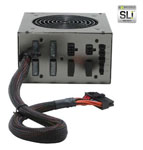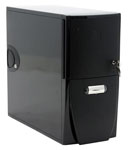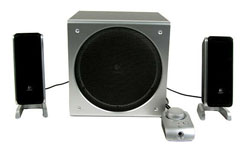Mid-Range Buyer's Guide, September 2005
by Jarred Walton on September 19, 2005 12:05 AM EST- Posted in
- Guides
Remaining Recommendations
We've covered the major components of the systems, and all that remains are the accessories. There isn't much new to say on the majority of these parts, and our Price Guides cover each area in more detail. Here are the rest of the components, and for most of them personal preference will play a large part in determining what you get. If you want higher quality speakers, you'll need to spend more money. A faster hard drive (or multiple hard drives) is definitely an option, but for most people it won't have a major impact - we generally prefer storage capacity and low noise levels over a small increase in HDD performance. Case, power supply, and optical storage choices round out the final components.
We have two lists of the remaining parts, one for the gaming configurations and the other for the office setups. We tried to balance the final system cost as much as possible, but the simple truth is that a good gaming/enthusiast setup requires more expensive parts than a business configuration. You can always downgrade some of the components to cheaper alternatives, but if we were building a computer for our own use, we'd rather save up for better quality than settle for lower cost.
Gaming Components:
Office Components:
Most of the choices should be pretty self-explanatory, so we just want to touch on the important areas. First, we've chosen to use a higher end power supply for the gaming configuration. Many people think that the modular power supplies are nice as they help to eliminate cable clutter, though some of the cables are a little stiff and can be difficult to route. The SunBeam 550W that we've chosen includes two PCIe power connectors, which would be required for an SLI configuration. (If you're running high-end components in an SLI setup, we'd think twice about using simple molex-to-PCIe adapters.) $86 for a power supply is a lot of money, but that's better than having random system crashes caused by exceeding the PSU load levels. Antec, OCZ, Enermax, and a few others also have some SLI-ready power supplies, though most cost upwards of $100 (and we'd avoid anything claiming SLI readiness that costs under $75).
Both setups use pretty low-end speaker arrangements. The Z-3e speakers sound good for the price, but they're not at the level of something like the Z-5500 or Klipsch, and true audiophiles would scoff at either of those "high end" choices that we just mentioned. If you're serious about audio quality, you probably already know more than what we typically cover in the Buyer's Guides. (The entire Logitech line of speakers is pretty reasonable if you're looking for other options. We've recommended them many times in the past, and this isn't really a change in recommendation so much as an alternative that you might consider.) We also stick with the integrated audio solutions for all of the systems, though the Karajan adapter of the DFI board certainly offers the best overall quality of the four boards. While there is a difference between integrated audio and discrete audio solutions, you'll need better speakers before it really begins to matter.
Our hard drive and optical drive selections are essentially a toss up. Our last Hard Drive Roundup showed that SATA 3.0Gbps drives were faster in some areas, NCQ could help out in certain tests as well, but there was no clear victor. All things being equal, we'll go for cost per GB, and for the dual-core systems, we'll also grab an NCQ enabled drive. Some people would rather have a better warranty like the 5-year Seagate and Western Digital Raptor or Caviar RE. If you ever need to use that warranty, though, you'll probably be pretty unhappy - the data on the drive is almost always more important than the drive itself. That's why a good backup strategy is important, and the DVDR drives that we've listed will get you started. We should also mention that firmware updates to the NEC 3540A and BenQ DW1640 drives have ironed out most of the media compatibility issues, so either drive is a good purchase.
We've covered the major components of the systems, and all that remains are the accessories. There isn't much new to say on the majority of these parts, and our Price Guides cover each area in more detail. Here are the rest of the components, and for most of them personal preference will play a large part in determining what you get. If you want higher quality speakers, you'll need to spend more money. A faster hard drive (or multiple hard drives) is definitely an option, but for most people it won't have a major impact - we generally prefer storage capacity and low noise levels over a small increase in HDD performance. Case, power supply, and optical storage choices round out the final components.
We have two lists of the remaining parts, one for the gaming configurations and the other for the office setups. We tried to balance the final system cost as much as possible, but the simple truth is that a good gaming/enthusiast setup requires more expensive parts than a business configuration. You can always downgrade some of the components to cheaper alternatives, but if we were building a computer for our own use, we'd rather save up for better quality than settle for lower cost.
 |
 |
 |
| Click images to enlarge. | ||
Gaming Components:
| Hard Drive: | Western Digital SATA II 160GB 7200RPM 8MB Caviar SE | $81 |
| Optical Drive: | BenQ DW1640 Black (OEM) | $43 |
| Case: | Cooler Master Cavalier 3 CAV-T03-UK | $76 |
| Power Supply: | SunBeam 550W NUUO SUNNU550-US-BK Modular PSU | $86 |
| Speakers: | Labtec ARENA 685 5.1 Speakers | $48 |
| Keyboard and Mouse: | Logitech Internet Pro Desktop | $23 |
 |
 |
 |
| Click images to enlarge. | ||
Office Components:
| Hard Drive: | Hitachi SATA 250GB 7200RPM 8MB Deskstar 7K250 NCQ | $120 |
| Optical Drive: | NEC 3540A Black (OEM) | $42 |
| Case and Power Supply: | Antec Sonata II + SmartPower 2.0 450W PSU | $115 |
| Speakers: | Logitech Z-3e 2.1 Speakers | $73 |
| Keyboard and Mouse: | Logitech Internet Pro Desktop | $23 |
Most of the choices should be pretty self-explanatory, so we just want to touch on the important areas. First, we've chosen to use a higher end power supply for the gaming configuration. Many people think that the modular power supplies are nice as they help to eliminate cable clutter, though some of the cables are a little stiff and can be difficult to route. The SunBeam 550W that we've chosen includes two PCIe power connectors, which would be required for an SLI configuration. (If you're running high-end components in an SLI setup, we'd think twice about using simple molex-to-PCIe adapters.) $86 for a power supply is a lot of money, but that's better than having random system crashes caused by exceeding the PSU load levels. Antec, OCZ, Enermax, and a few others also have some SLI-ready power supplies, though most cost upwards of $100 (and we'd avoid anything claiming SLI readiness that costs under $75).
Both setups use pretty low-end speaker arrangements. The Z-3e speakers sound good for the price, but they're not at the level of something like the Z-5500 or Klipsch, and true audiophiles would scoff at either of those "high end" choices that we just mentioned. If you're serious about audio quality, you probably already know more than what we typically cover in the Buyer's Guides. (The entire Logitech line of speakers is pretty reasonable if you're looking for other options. We've recommended them many times in the past, and this isn't really a change in recommendation so much as an alternative that you might consider.) We also stick with the integrated audio solutions for all of the systems, though the Karajan adapter of the DFI board certainly offers the best overall quality of the four boards. While there is a difference between integrated audio and discrete audio solutions, you'll need better speakers before it really begins to matter.
Our hard drive and optical drive selections are essentially a toss up. Our last Hard Drive Roundup showed that SATA 3.0Gbps drives were faster in some areas, NCQ could help out in certain tests as well, but there was no clear victor. All things being equal, we'll go for cost per GB, and for the dual-core systems, we'll also grab an NCQ enabled drive. Some people would rather have a better warranty like the 5-year Seagate and Western Digital Raptor or Caviar RE. If you ever need to use that warranty, though, you'll probably be pretty unhappy - the data on the drive is almost always more important than the drive itself. That's why a good backup strategy is important, and the DVDR drives that we've listed will get you started. We should also mention that firmware updates to the NEC 3540A and BenQ DW1640 drives have ironed out most of the media compatibility issues, so either drive is a good purchase.










56 Comments
View All Comments
flatblastard - Tuesday, September 20, 2005 - link
This was my only beef with the guide as well. Seems like at stock speeds you would have a mostly "entry-level" performer thats trying to be on the "high-end" with other components. I suppose at higher resolutions the 7800GT would come in handy, but again, we are talking about "mid-range" where the screen would be between 17-19 inches.JarredWalton - Tuesday, September 20, 2005 - link
Hence, the disclaimer on the bottom of page 4. I'll be publishing an article looking more into the how-to of overclocking, and rest assured I will be spending a decent amount of effort advising people to not assume too much. Still, all overclockers have to start somewhere.I personally have yet to see a Venice 3000+ that can't run 2.4 GHz - provided the user knows what they're doing and has an appropriate motherboard. Mine runs 2.7 GHz and almost 2.8 GHz (i.e. 2.8 crashes in several tests). However, overclocking is part art and part science. You have to put a lot of effort into getting the best results, and a lot of people just want it to be easy. Oh, well.
danmitchell - Monday, September 19, 2005 - link
Can you please elaborate on this? My 19" CRT is failing and I was thinking of replacing it with a 1905FP.huges84 - Tuesday, September 20, 2005 - link
I too am interested in that statement. It was important enough to you to put into bold, but I don't see much of an explaination for it.JarredWalton - Tuesday, September 20, 2005 - link
Basically, spending more money on a bigger, better display isn't a bad idea if you can afford it. A 19" LCD is what I would call the bare minimum for a Mid-Range system. A 20 or 21" with native 1600x1200 resolution would be better, in my opinion - perhaps not for gaming, but certainly for office work. If you're happy with a 19" LCD, then go ahead and purchase one; I was merely pointing out that people ought to at least consider the larger options for a moment. :)BladeVenom - Monday, September 19, 2005 - link
With Battlefield 2 and for future games they should really be recommending 2 GB of RAM for a gaming machine.JarredWalton - Monday, September 19, 2005 - link
Read the memory page. More RAM is suggested, particularly for BF2 and FEAR. It isn't in the final table because that would add another $100 to the price.SimonNZ - Tuesday, September 20, 2005 - link
I have a rig similar to that with a few higher end components and my 1gb DRR500 does me easily in FEAR and BF2, all setting maxed, full AA/ AF etc so more ram and need, the mobo would be running it in dual channel 2:)deathwalker - Monday, September 19, 2005 - link
It's a truely great list of hardware..no argument with that. But I just don't see a DFI SLI mobo at $165 and a 7800 GT graphics card at $380 being "Mid-Range" equipment. Hell..all you have to do is update the Processor recommendation and it vaults right into High end equipment.deathwalker - Monday, September 19, 2005 - link
I guess what it comes down to ..is that I don't think $1500 is an appropriate mid-range budget.